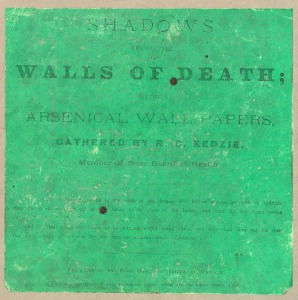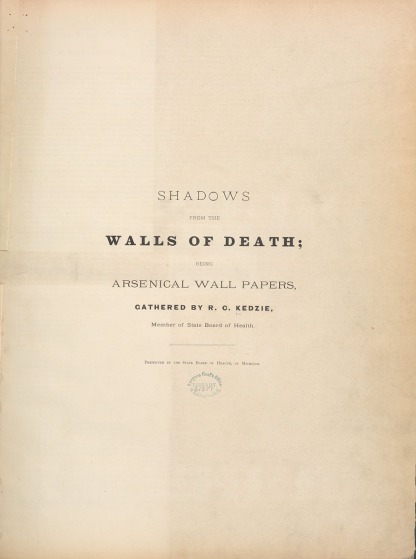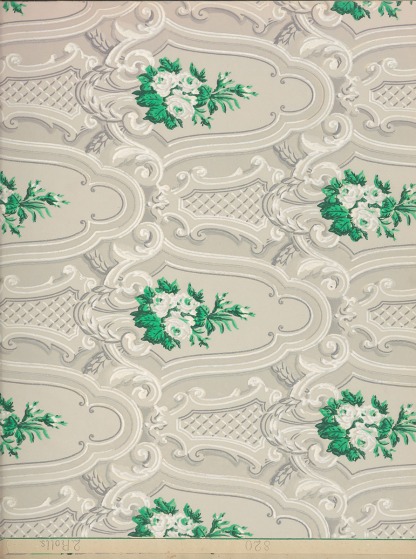NLM has digitized and made publicly available for the first time, one of four known copies of Shadows from the Walls of Death: Facts and Inferences Prefacing a Book of Specimens of Arsenical Wall Papers, 1874. In this three-part series learn more about the origins of this rare book, the digitization effort, and the arsenic pigments of the 19th century.
By Krista Stracka ~ Krista Stracka is a Rare Book Cataloger for the Rare Books and Early Manuscripts Section in the History of Medicine Division at the National Library of Medicine.
In a digitization workflow, the assessment of the physical condition of each book is a critical step to determine whether its fragile pages can withstand the rigors of scanning without damage. However, for one book in the NLM collection, these considerations also had to be flipped. Aside from a random paper cut, what if the book itself could potentially harm the person scanning each page? Contained inside the binding of the rare but increasingly popular Shadows from the Walls of Death: Facts and Inferences Prefacing a Book of Specimens of Arsenical Wall Papers are 84 samples of wallpaper sheets colored with arsenical pigments. In appreciation of North American Occupational Safety and Health (NAOSH) Week, this three-part series will provide a behind-the-scenes look at actions that were taken by NLM staff to safely scan this curious book (now available online) and the hazardous pigments contained inside.

National Library of Medicine #0234555
The inclusion of these pigments was intentional, as you may have guessed by the dramatic title. Published in 1874, Shadows from the Walls of Death was written and compiled by Dr. Robert C. Kedzie to raise awareness about the beautiful yet toxic pigments used by many wallpaper manufacturers. Shadows from the Walls of Death is composed of a letter of introduction issued by the Michigan State Board of Health and an eight-page preface by Dr. Kedzie, the Chairman of Committee on Poisons, followed by over 80 arsenical wallpaper samples. Dr. Kedzie purchased these samples from leading dealers in Lansing, Detroit, and Jackson to compile 100 copies that were then distributed to public libraries in the state of Michigan. Out of concern for patron health, most copies have been discarded or destroyed and only four are known to exist today. The National Library of Medicine’s copy was sent in 1874 to John Shaw Billings, who was then serving as director of the Library of the Surgeon General’s Office. The other three surviving copies are located at the University of Michigan, Michigan State University, and Harvard University.
Although arsenic has been used as poison and as medicine since antiquity, the nineteenth century witnessed a surge in its use in industry to manufacture consumer goods, earning the nickname “the arsenic century” from historian James Whorton. Coloring agents containing arsenic were both cheap to produce and capable of yielding vivid hues. In particular, the vibrant shades of Sheele’s and Paris green pigments became especially fashionable, leading to a demand for a variety of goods in these colors, including clothing, furniture, playing cards, toys, food…and wallpaper. Of these products, wallpaper raised much concern from the medical profession and the public as reports of illness increased with exposure to the poisonous substance in the home and on the job. Nausea, headaches, diarrhea, joint pain, skin diseases, and other symptoms of arsenical poisoning were reported to disappear once time was spent away from the offending pigments.
Concerns about the toxic effects of arsenical wallpaper were raised as early as 1839 when German chemist Leopold Gmelin submitted a letter to a newspaper about his own findings. Although demand in the United States decreased temporarily, warnings were brushed aside by consumers as manufacturers and members of the medical profession questioned the hazards. Symptoms of arsenic poisoning were easily mistaken for those of cholera or dysentery. Susceptibility varied widely among individuals exposed to the wallpaper—even within the same household—leading many to doubt its harmfulness. Aside from physical effects, employment was another driving factor. The use of these pigments was quite lucrative, providing work for many who accepted the conditions as part of the job. With these conflicting messages, arsenical greens became highly fashionable again in the 1860s.
In response to this resurgence, education campaigns increased in the next decade to eliminate the use of arsenical pigments. As Dr. Frank Draper stated in the 1872 Annual Report of the State Board of Health of Massachusetts, “the demand ceasing, the supply will cease; and a correct taste in color will find its gratification in agents which possess no poisonous character.” Two years later, the Shadows from the Walls of Death campaign was created in Michigan. By sending the book to the leading libraries in Michigan, Dr. Kedzie went a step further than other campaigns to make the information accessible to the public. Through these efforts, demand increased for safer products which ultimately led manufacturers to produce arsenic-free wallpaper. The benefits reached both the consumers and the workforce.
By digitizing this copy, The National Library of Medicine went one step further to be the first library to make Shadows from the Walls of Death freely accessible to the everyone online. Before sending the book through to the scanning stage of the digitization workflow, NLM staff were careful to consider employee exposure and contacted the NIH Department of Occupational Health and Safety (DOHS) for guidance on the recommended protection to use while scanning arsenical wallpaper and for future handling of similar materials, because Dr. Kedzie was not the last to include samples of arsenical wallpaper in a publication!
On Wednesday—National Occupational Health and Safety Professional Day—learn more about the safety analysis and sampling performed in cooperation with DOHS in Part 2 of this series!
Like a good mystery? Discover Shadows from the Walls of Death as seen on Mysteries at the Museum “Jack the Ripper, Wooden Money, Deadly Décor” which premiered Thursday, July 12 at 10 p.m. ET/PT on Travel Channel.










